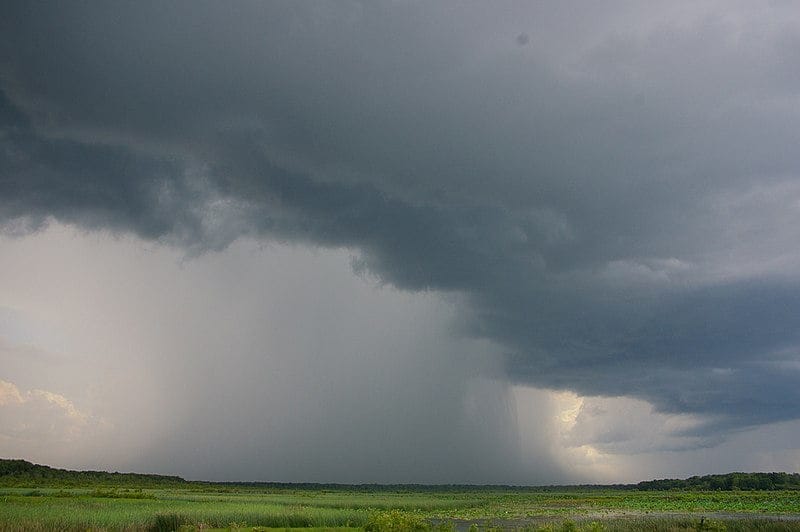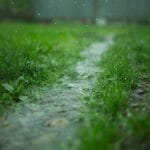Ever wonder what really goes into a rainstorm? What makes it tick, how it starts, and why it ends? Scientists and meteorologists have delved into the intricacies of rainstorms to shed light on these captivating weather events. Get ready to explore the world of rainstorms and uncover the fascinating mysteries they hold!
Rainstorm Facts
We all know that feeling – the sky turning a brooding gray, the wind picking up, and then, those first fat raindrops splattering down. Rainstorms are a regular part of life for many of us, but their potential power might surprise you.
While hurricanes and tornadoes often dominate headlines, rainstorms can actually be more deadly. The primary threat often isn’t the rain itself, but the flash floods that frequently accompany it. Rushing water possesses incredible power, capable of sweeping away cars, homes, and tragically, even people.
And then there’s the spectacle of lightning. This electrifying phenomenon, a staple of many rainstorms, is captivating to watch, but it’s crucial to remember its potential danger. Lightning strikes ignite countless fires annually and can, unfortunately, be fatal.
Rain’s fury isn’t limited to water and light, though. Ever experienced a hailstorm? These icy missiles, sometimes resembling golf balls or larger, plummet from the sky, causing significant damage. They can shatter car windows, damage roofs, and even injure people and animals.
Perhaps the most bizarre phenomenon associated with rainstorms is the documented, albeit rare, occurrence of animals falling from the sky. While it sounds like something straight out of a movie, scientists suggest powerful updrafts, commonly found in thunderstorms, can lift small creatures like fish, frogs, and even toads high into the air. These hapless passengers are then carried long distances before being deposited back to earth with the downpour.
The next time you observe a rainstorm gathering force, remember there’s more to these meteorological marvels than meets the eye. They offer a powerful reminder of nature’s raw power, capable of breathtaking beauty and potent destruction.
What are some interesting facts about rainstorms?
Have you ever noticed that a raindrop splattering on your window doesn’t really look like the classic teardrop shape? It’s more like a tiny hamburger bun! This flattened form is due to air resistance pushing against the bottom of the raindrop as it falls.
Beyond their unique shape, raindrops play a critical role in sustaining life on Earth. They nourish plants, help regulate the planet’s temperature, and replenish lakes and rivers. Without rain, our world would be a drastically different place.
However, it’s important to note that not all rain is beneficial. “Acid rain” results when pollution mixes with rainwater, increasing its acidity and causing harm to the environment. This acidic rain can damage forests, lakes, and even buildings. Scientists are actively researching ways to reduce this type of pollution.
One of the most enjoyable aspects of rain is the amazing smell that follows a downpour. This fresh, earthy scent, known as “petrichor,” originates from the soil and plants. It’s released when rain interacts with specific compounds in the ground, acting like the Earth’s refreshing “thank you” for the much-needed hydration.
What are 5 interesting facts about thunderstorms?
Key Takeaways:
- Thunderstorms are like giant batteries in the sky, unleashing energy comparable to ten atomic bombs!
- They manifest in different “flavors” – single-cell, multi-cell, and the mighty supercell – each with its own personality and strength.
- Their birth involves a complex dance of atmospheric forces, whipping up electricity and chaos in the air.
- While they deliver life-giving rain, they can also unleash fury through lightning, hail, and flash floods.
- Despite being a common occurrence, thunderstorms still hold mysteries that scientists are working hard to unravel.
We know thunderstorms can pack a punch, releasing energy that could rival ten atomic bombs! It’s a mind-boggling display of nature’s power, but there’s much more to these meteorological marvels than their sheer force.
Think of thunderstorms as different types of fireworks. Some, like single-cell storms, are like sparklers – brief and intense. Multi-cell storms resemble Roman candles, with multiple bursts of energy. Then there are supercells – the grand finale – capable of spinning off tornadoes and unleashing the most destructive hailstorms.
The formation of these atmospheric behemoths involves a delicate recipe: warm, moist air collides with cooler, drier air. Add a dash of wind shear (changes in wind speed and direction), and you have the perfect conditions for a thunderstorm to brew. As the warm air ascends, it cools and condenses, forming the thunderclouds we call cumulonimbus clouds. Within these towering cloud formations, tiny ice crystals collide with larger hailstones, creating static electricity – the source of those awe-inspiring lightning bolts.
As much as we marvel at their power, thunderstorms are essential for a healthy planet. They water our crops, replenish rivers and lakes, and help regulate Earth’s temperature. And let’s not forget that characteristic fresh, earthy scent after a downpour – petrichor – a chemical released from the soil, reminding us of nature’s rejuvenating power.
While the basic mechanisms of thunderstorms are understood, there’s still much to learn. Scientists are actively researching how they form, why some become so intense, and how we can better predict their behavior. So, the next time you find yourself seeking shelter from a raging storm, remember you’re witnessing one of nature’s most powerful and mysterious phenomena.
What are some facts about rainwater?
We all know rainwater is essential for life – it nourishes our gardens and keeps our lakes full. But have you ever wondered what else might be in those drops splashing on your window? Let’s dive into some fascinating facts about rainwater!
- It’s not as pure as you think. While it might appear crystal clear falling from the sky, rainwater actually collects tiny particles present in the atmosphere, such as dust, smoke, and even gases. Consequently, rainwater reaching the ground isn’t perfectly pure H2O.
- It’s a bit on the acidic side. Those particles collected from the air contribute to rainwater being slightly acidic. While we’re not talking battery acid levels, with a pH around 5.6, it’s more acidic than pure water. This slight acidity generally isn’t a major concern, but it becomes problematic when we discuss acid rain.
- Acid rain is a real buzzkill for the environment. Remember those pollutants in rainwater? When we release excessive amounts of certain pollutants like sulfur dioxide (from factories) and nitrogen oxides (from cars), rainwater can become significantly more acidic. This acid rain has serious consequences. It can harm trees and plants, make lakes and rivers less hospitable to fish, and even damage buildings over time.
- That pitter-patter on the roof? It might be good for you! The soothing sound of rain often has a calming effect. This gentle, rhythmic sound can relax our brains, helping us de-stress. Some people even find recordings of rain sounds helpful for sleep or concentration!
- Rainforests really love rain (hence the name!). These lush, vibrant ecosystems are known for their incredible biodiversity, which is largely due to the abundant rainfall they receive. Rainforests can receive over 100 inches of rain annually! This constant downpour creates the perfectly damp and humid environment for a vast array of plants and animals to thrive.
- Rainwater harvesting: It’s not just for hippies anymore! Even though rainwater isn’t pure, it doesn’t mean it’s useless! We can collect and use rainwater for various purposes, like watering gardens, washing cars, and even flushing toilets. This practice, called rainwater harvesting, is gaining popularity as a way to conserve water and save money.
Want to learn more about rainwater and its impact on our world? Check out the National Oceanic and Atmospheric Administration’s resources on rainwater harvesting (https://www.noaa.gov/education/resource-collections/climate/rainwater-harvesting). Happy reading!
What are 5 facts about rain for kids?
We’ve already learned a bit about rain, but there’s always more to discover! Let’s explore some fun facts about those cool drops that fall from the sky!
- Rain is like a tall drink of water for our planet! Just like we get thirsty, plants and animals need water to survive too. Rain is essential because it provides all living things with the water they need to grow and thrive. Without rain, Earth would be a much drier place.
- Sometimes, rain can get a little too excited! Imagine a bathtub overflowing – that’s similar to what happens during a flash flood. When a lot of rain falls in a short time, the ground can’t absorb it all fast enough, leading to potentially dangerous flash floods that can cause damage.
- Have you ever noticed that rain has a special smell? That fresh, earthy scent is called petrichor! Scientists believe this smell comes from plants and tiny organisms in the soil releasing a special scent when raindrops hit the ground. It’s like a signal announcing, “Yay, rain is here!”
- Rain can be like a lullaby for your mind and body. That calm, relaxed feeling you get listening to raindrops is real! The gentle pitter-patter of rain can be very soothing, even helping some people fall asleep!
- Rain is a bit of a traveler! It’s part of a remarkable journey called the water cycle. Imagine water constantly moving between the earth and the sky. Rain happens when water in the atmosphere cools down and turns into those little droplets that fall back to the ground. It’s like a big, exciting game of water tag between the earth and the sky!
There’s still so much to learn about rain! Keep your eyes peeled and your curiosity high – you never know what amazing things you might discover about this essential part of our world!
What are 2 interesting facts about storms?
We’ve delved into rainstorms and their peculiarities, but let’s plunge deeper into some captivating facts about these weather wonders.
Remember those perfectly shaped teardrop raindrops we often picture? Turns out, that’s not entirely accurate! As a raindrop descends, air resistance molds it, creating a flatter bottom, more akin to a hamburger bun falling from the sky!
And get this – rainstorms resemble giant batteries in the sky. Scientists believe a single storm can generate as much energy as several atomic bombs! Imagine if we could harness all that power—we might not need fossil fuels anymore!
Now, consider thunderstorms, which take things to a whole new level. Did you know that our planet experiences roughly 16 million thunderstorms annually? That’s a lot of lightning! Speaking of lightning, the energy contained within a single thunderstorm is astounding. Some experts estimate it’s equivalent to around ten atomic bombs! That’s enough power to energize a city for an extended period. Perhaps one day we’ll discover how to harness that lightning for good.
Storms aren’t just about raw power; they also possess a delicate side. Consider that fresh, earthy smell after a good rain – petrichor. This pleasant aroma arises from a unique blend of chemicals in the soil, released when raindrops make contact. It’s as if the earth is exhaling a sigh of relief after a good soak.
There’s still much we don’t know about storms, but that’s part of what makes them so fascinating. They remind us that nature is full of surprises, waiting to be discovered.
What are 5 interesting facts about weather?
We’ve all gazed at the sky, contemplating the rain, wind, and sunshine. Weather is a constant in our lives, yet it’s full of surprises. For instance, did you know that rain isn’t always plain old rain? Depending on what’s floating around in the air, raindrops can take on different colors! Imagine witnessing a shower of red, orange, or even yellow rain. While it might sound like something out of a fantasy, this phenomenon occurs when dust and other particles become trapped in raindrops as they fall.
Speaking of rain, have you ever pondered how its distribution varies across the globe? Certain regions are fortunate enough to receive a consistent, gentle shower throughout the year. Meanwhile, other areas experience distinct wet and dry seasons, as if the Earth is inhaling and exhaling. These diverse rainfall patterns contribute to the incredible variety we see on our planet.
While we might envision raindrops as perfectly pure, crystal-clear droplets of water, the reality is they act like tiny sponges, collecting particles they encounter during their descent to Earth. So, that raindrop landing on your nose is a tiny capsule of atmospheric dust and particles!
Let’s transition to a more dramatic weather event: thunderstorms. The brilliant flashes of lightning and resounding thunderclaps are awe-inspiring. Scientists estimate that approximately 16 million thunderstorms occur on Earth each year – a constant, global fireworks display orchestrated by nature itself!
Beyond their captivating displays, rain plays a vital role in sustaining life on our planet. It acts like a massive watering can for plants and animals, replenishing water sources, and maintaining healthy ecosystems. Rain also helps regulate Earth’s temperature, functioning like a natural air conditioner to prevent excessive heat.
It’s fascinating how something as seemingly simple as rain can be so complex and intriguing. The next time you find yourself in a downpour, take a moment to appreciate the wonders of weather unfolding above.
What is the longest rainstorm in history?
We’ve all experienced those stretches of seemingly endless rain, but have you ever wondered about the absolute longest a rainstorm has lasted? Prepare to be amazed as we delve into some incredibly soggy history.
Imagine yourself in Honomu Maki, Hawaii, in 1913. Now, picture the rain starting—and not stopping for almost three years! This record-breaking event saw an incredible 881 days of continuous rainfall, believed to be the longest stretch of uninterrupted rain ever documented.
Hawaii isn’t the only location with impressive rainfall statistics. On the island of Maui, Manuawili Ranch experienced an astonishing 331 consecutive days of rainfall between 1939 and 1940. That’s nearly an entire year of non-stop precipitation!
Shifting to the mainland United States, the crown goes to Otis, Oregon. In 1997, they endured a grueling 79 days of continuous rain—over two months of gray skies and dampness.
It’s important to remember that these incredible records are based on available information. Consider remote areas or locations lacking consistent weather data collection throughout history. It’s plausible, even likely, that even longer periods of rain have occurred but were never officially recorded.
As scientists refine their methods and uncover more historical data, our understanding of these weather events continues to evolve. Who knows what other record-breaking rainstorms might emerge from the annals of weather history?
How long can rainstorms last?
We’ve discussed what triggers a rainstorm, but the duration of these events is a bit more complex. It’s similar to baking a cake—some bake quickly, while others seem to linger in the oven forever. Rainstorms exhibit a similar variability.
Your average, everyday rain shower might only last for 30 minutes or so—like those times you get caught in a quick downpour running errands. These brief bursts are typically light and vanish as quickly as they appear. A steadier rain, the kind perfect for curling up with a good book, might persist for a couple of hours.
Thunderstorms, however, are the heavy hitters, bringing the full arsenal of heavy rain, booming thunder, and often, hail. These powerful storms usually unleash their fury within 30 to 60 minutes for each “cell” – think of a cell as one small storm cloud within a larger system. However, a single thunderstorm can be comprised of multiple cells, potentially extending the overall duration for a few hours.
Rainstorms associated with weather fronts can also be long-lasting. These fronts, which bring about a shift from sunny and warm to cool and rainy, represent a boundary between two distinct air masses. They can usher in hours of steady rainfall, potentially persisting for a full day or two!
And then there are the record-breaking storms, those that refuse to quit. The champion, as previously mentioned, occurred in Honomu Maki, Hawaii, where it rained for almost three consecutive years, from 1913 to 1916, setting the record for the longest documented rainstorm at an incredible 881 days.
So, what causes some storms to be fleeting while others overstay their welcome? A multitude of factors come into play, including atmospheric conditions like temperature, humidity, and wind patterns. Geographical location also influences rainfall duration, as coastal areas and mountainous regions tend to experience more frequent and intense storms.
Furthermore, long-term climate patterns like El Niño and La Niña can influence rainfall patterns and storm frequency. Predicting the duration of a rainstorm is a complex endeavor, akin to solving a puzzle. Meteorologists utilize sophisticated tools and data to make their best predictions. Understanding these patterns is crucial for predicting floods, ensuring public safety during severe weather, and even making simple decisions like whether or not to bring an umbrella.
What are the benefits of rainstorms?
We often focus on the destructive power of rainstorms, but they also play a vital role in maintaining a healthy planet. Think of them as a giant “refresh” button for our environment! Let’s explore some of the ways rainstorms benefit us:
- Think of them as giant water bottles for our planet. Rainstorms replenish our rivers, lakes, and those vast underground water reserves (aquifers) we rely on. This water is essential for drinking, agriculture, and supporting diverse ecosystems.
- Plants absolutely love them. Plants, much like people, thrive on water. Rainstorms provide that much-needed hydration, helping them grow strong and healthy, resulting in the lush landscapes and delicious produce we enjoy.
- They’re like nature’s sculptors. While heavy rain can cause erosion, over time, it also plays a role in shaping the land. Rain acts as a patient artist, gradually carving out valleys and shaping the diverse landscapes we see around us.
- Feeling stressed? A rainstorm might help! The sound of raindrops and the earthy aroma of petrichor often have a calming effect. Studies suggest that these sensory experiences can help us relax and de-stress.
- They give the air a good scrub. The air often feels fresher after a rainstorm because rain acts as a natural air purifier, removing dust, pollen, and other pollutants. So, the next time you take a deep breath of clean, fresh air, thank a rainstorm.
- Animals depend on them too. Rainstorms are essential for animals as well, replenishing watering holes and encouraging the growth of plants that provide food and shelter. It’s a win-win situation for the entire ecosystem.
- They’re more than just weather. In many cultures, rainstorms hold deep spiritual significance. They are viewed as symbols of renewal, cleansing, and new beginnings. It’s fascinating how weather events can carry such profound cultural meanings.
The Science Isn’t Settled
While we know a great deal about the benefits of rainstorms, there’s still much to learn. For instance, scientists are researching how climate change might impact rainfall patterns and the potential consequences for our planet. Understanding the complex relationship between rainstorms and our environment is crucial.
What is the cause of rainstorms?
We’ve all experienced a sudden downpour, but have you ever considered what causes these rainstorms? The process is more fascinating than you might think!
In essence, rain occurs when tiny water droplets within clouds become too heavy to remain suspended in the air, falling to the ground like an overfilled water balloon.
These water droplets form when warm, humid air rises into the atmosphere. As this warm air ascends, it cools, causing the water vapor within it to condense into tiny water droplets, much like a bathroom mirror fogging up after a hot shower, but on a much larger scale. These droplets congregate, forming clouds.
These droplets don’t just remain static within the cloud. They collide and merge, growing larger and heavier. Eventually, they reach a point where the air can no longer support their weight, and they fall to the ground as rain.
Of course, the process is a bit more nuanced than that. Several factors contribute to rainstorm formation:
- Atmospheric instability: Similar to a pot of simmering water, the atmosphere needs to be unstable for rainstorms to form. This instability allows warm, moist air to rise rapidly, leading to cloud formation and, eventually, rain.
- Moisture: This one is fairly straightforward—no moisture in the air, no rain! The more humid the air, the greater the potential for heavy downpours.
- Condensation nuclei: Tiny particles in the air, such as dust, pollen, and even salt from the ocean, act as “condensation nuclei,” providing a surface for water vapor to cling to as it cools and condenses, facilitating the formation of raindrops.
- Updrafts: Much like a kite soaring higher as the wind catches it, updrafts, or upward movements of air, give water droplets a boost, helping them stay aloft within the cloud for more extended periods.
Understanding the causes of rainstorms is crucial, especially in the context of climate change, which is contributing to more extreme weather events, including more intense rainstorms and flooding. By understanding how rainstorms form and the factors influencing their intensity, scientists hope to improve weather forecasting and help communities better prepare for these events.
While mysteries remain about the intricacies of rainstorm formation, one thing is certain: a deeper understanding of these weather phenomena is vital for protecting ourselves and adapting to a changing climate.
Are you curious about the definition of torrential rain? If so, click on that link and gain all the information you need. Besides that, if you wish to explore more, you can also check out drizzly rain.
- Unveiling the Enigma: Mansoureh Khojasteh Bagherzadeh’s Public Appearances & Private Life in Iran - July 18, 2025
- Unveiling the Mystery: Mansoureh Khojasteh Bagherzadeh’s Husband: A Rare Glimpse into a Private Life - July 18, 2025
- Unveiling Masoud Khamenei’s Mother: Power, Influence, and Iran’s Future - July 18, 2025
















